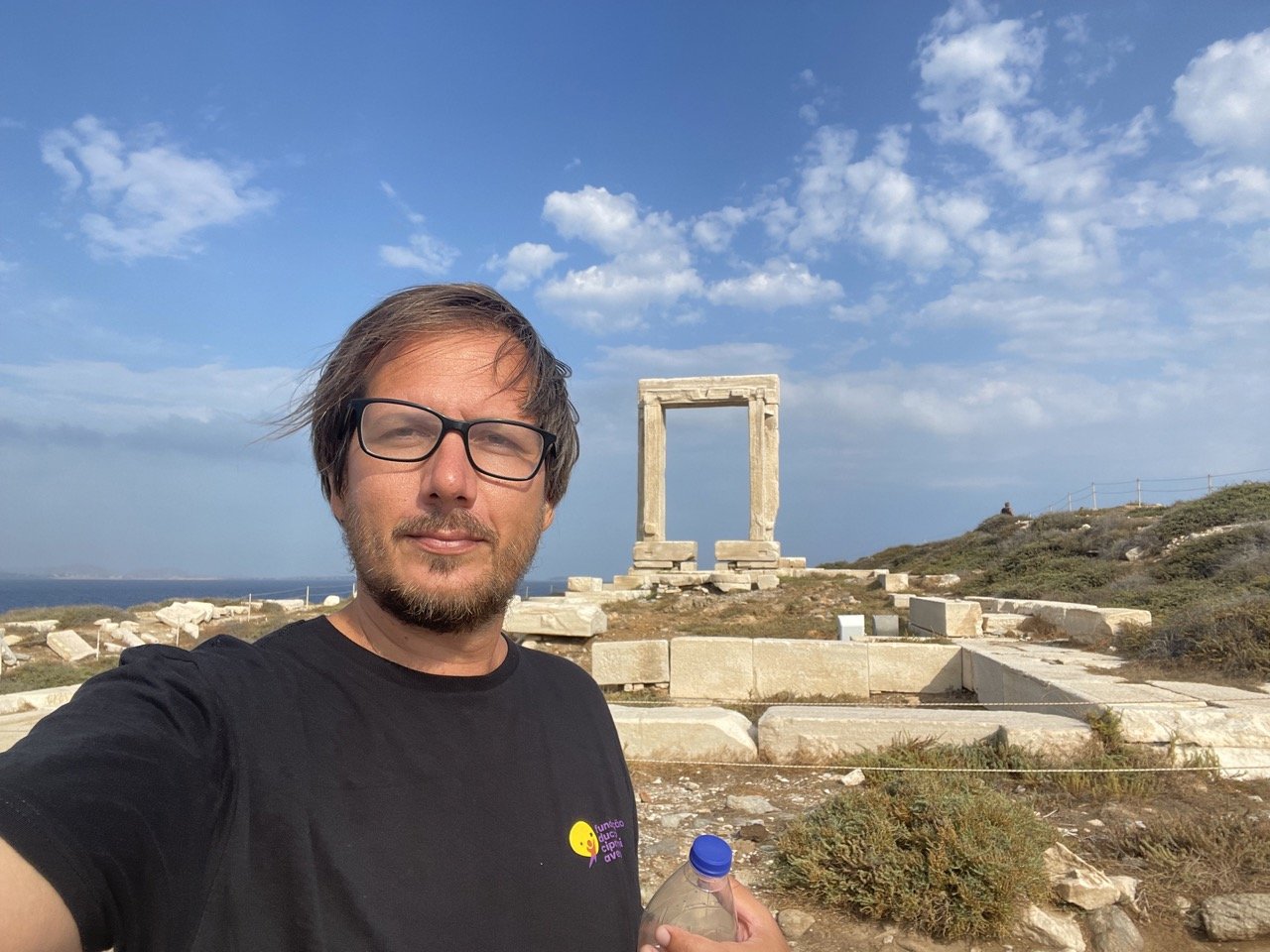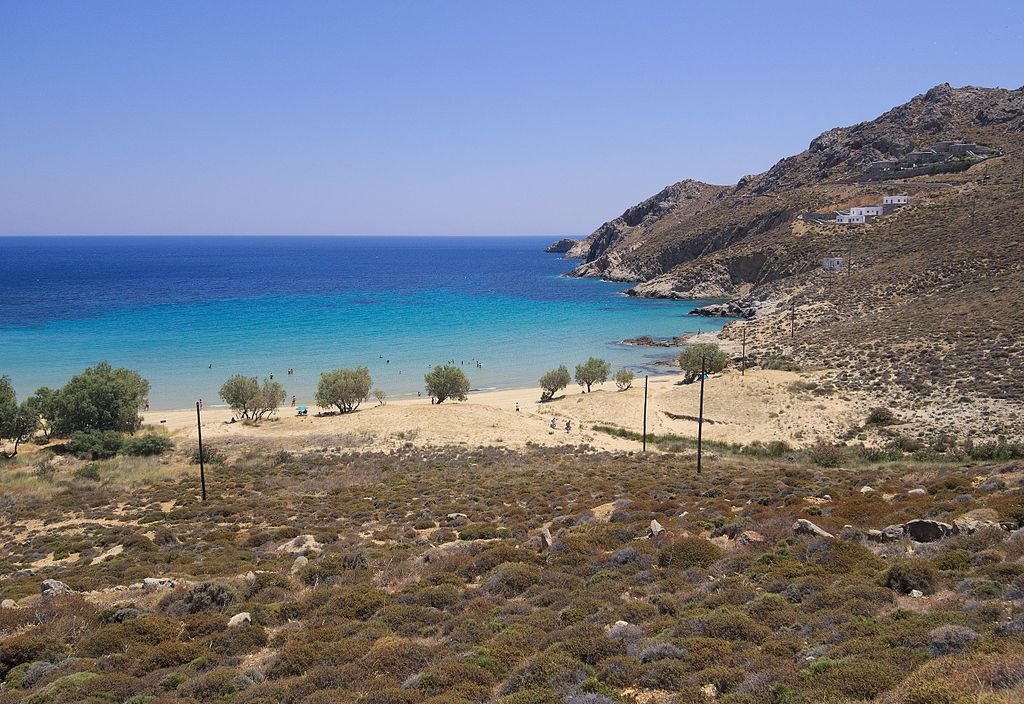A Local’s Guide to Visiting Serifos, Greece
Affiliate disclosure: some of the links in this article are affiliate links. If you book using one of them, we’ll earn a small commission. All of our info is free to read and free of ads, so we appreciate it!
The charming island of Serifos is an ideal destination in the Western Cyclades anyone seeking a mix of tranquility, adventure, and wild natural beauty. Serifos is far less visited than some of the more famous islands in the Cyclades complex, and as such only has moderate tourist infrastructure and offers a refreshing escape from commercialization and mass tourism.
The Chora, its main town, is considered one of the most beautiful in the Cyclades, and it towers above the island’s port, affording unique aerial views of the neighboring islands.
Geographically, Serifos is famous for its imposing landscapes and for the number and variety of excellent beaches in such a small area (it’s a relatively small island). It is also known for its abundance of churches, and for the many festivals that take place throughout the year.
Largely undeveloped, there are countless hiking paths that invite visitors to walk and discover the natural and historical sights that dot the island all over. If you’re looking for an uncrowded island that offers a taste of authentic island life and plenty of natural beauty, you would be hard pressed to find a better choice than Serifos.
Table of Contents


Where is Serifos
Photo: User: Bgabel at wikivoyage shared, CC BY-SA 3.0, via Wikimedia Commons
Serifos is an island located in the Western Cyclades, about 65 nautical miles southeast of Athens. Its neighboring islands are Kythnos to the north, and Sifnos to the south. Just off the northern tip of the island, you'll find the islets of Serifopoula and Piperi, while to the east lies the islet of Vous, in close proximity to the port of Livadi.
The island covers an area of about 29 square miles, and there are approximately 1,300 year-round inhabitants, mostly residing in the towns of Livadi and Chora.
How to get here
Serifos has no airport, so the easiest way to reach the island from mainland Greece is via direct ferry from Athens. If you’ll instead be coming from elsewhere in the Cyclades, there are various ferry connections with Serifos from other islands.
From Athens – by ferry
From April to October, there are usually two daily speedboat crossings between Athen’s Piraeus Port and Serifos’ Livadi port. Seajets runs the route and the journey takes about 2 hours, with one-way tickets costing approximately 65 euros. Departures from Athens are usually in the morning.
Additionally, Zante Ferries operates a year-round connection which has 3 to 4 departures per week, depending on the season. The route that Serifos is on includes stops at Kythnos, Serifos, Sifnos, Kimolos, Milos, Folegandros, Sikinos, Ios, and Santorini. The price starts at approximately 40 euros one way, and the journey taks around 5 hours.
Ferry connections with other islands
Serifos is connected with various other Cyclades islands year-round through a line that connects Syros, Paros, Sifnos, Kimolos, and Milos. The line runs twice a week, so always be sure to check the schedule and make sure that it works with your travel dates.
Where to buy ferry tickets
The main ferry companies serving Serifos include Seajets, Zante Ferries, Hellenic Seaways, and Aegean SeaLines.
To check schedules and prices, I recommend using Ferry Scanner which is an aggregator that shows options from a bunch of different ferry companies. Their schedules are always up to date, it’s easy to use, and the price difference between using them and booking direct is negligible.
Why visit
When I think of Serifos, it stands out to me as a place of contrasts, but its somewhere where those differences combine together seamlessly rather than in conflict. Here, you’ll find simplicity and luxury, crowds and silence, quiet tavernas and rowdy nights, and wild nature and calm beaches.
Serifos is an ideal year-round destination, and even in the peak months, it offers a wonderful blend of busy island life with absolute tranquility. One can explore the island by visiting its many beaches, hiking along its network of trails, diving into the past at its ancient sights, and enjoying all the amenities of modern life at its excellent restaurants, bars, and cafes.
Suitable for travelers of all tastes and budgets, Serifos also had a wide array of hotels, ranging from budget offerings to luxury establishments.
While the island offers a nice mix of activities to travelers, the beaches are undoubtedly the star attraction. Despite not being an especially large island, there is an amazing diversity among the beaches here, with sandy, pebbly, and rocky ones all in abundance. Some are easily accessible and have calm waters, while others can only be reached via adventurous journeys.
There are organized beaches with facilities, restaurants and bars, etc., wild ones with nothing on or near them, some crowded, and others totally isolated even in August (e.g. Platis Gialos, Skala, Abessalos).
Despite their diversity, the beaches are very close to one another, so you can easily visit multiple in a single day, and have very different beach experiences one after the other.
And in case you don’t plan to while away every day at the beach, Serifos also has a few towns that are well worth visiting and exploring. The Chora is amphitheatrically built on a hill above the bay of Livadi, which once served as an observatory. The town is genuinely imposing, and it boasts gorgeous traditional Cycladic architecture that is delightful to observe while wandering through its narrow streets and alleys.
There are many options here for entertainment, dining and accommodation, and its immediate proximity to the port makes it very convenient.
Apart from Chora and the port (Livadi), other picturesque villages on Serifos include Panagia, Galani, and Kallistos, in the northern part of the island.
Serifos also has a rich history and many historical attractions dating from antiquity to modern times. Also called the “Iron Lady” owing to its mining history, the mines have influenced life here since the 6th century B.C. Thanks to them and the importance that they afforded the island, Serifos had its own coinage depicting the island’s animal mascot, the frog.


What is Serifos known for
From a purely touristic standpoint, Serifos is most well-known for its beaches, as mentioned above. With 72 in total, most of them with crystal clear waters, you can spend days just walking between the beaches and experiencing them one by one. For the most secluded though, you’ll need to rent a speedboat, which is itself an exhilarating experience.
Tourism aside, Serifos has been an important island since ancient times, and according to Greek mythology, Perseus, the son of Zeus and Danae, grew up here. Odysseus is also said to have passed through on his way back to Ithaca.
Serifos is also well known for its extensive mining history, particularly in the southwestern part of the island. Large iron deposits were mined between the beaches of Koutalas and Megalo Livadi until 1960, and the industry was the major economic driver here. In fact, in 1916, workers in Serifos went on strike, the first time this had ever happened in Greece.
If you wander around the area today, remnants of this intense mining activity form an open-air "natural museum", showcasing sections of railways, wagons, and unloading ladders. There is also a monument in the village of Megalo Livadi dedicated to the workers of the strike.
As mentioned above, Serifos’ Chora is a typical Cycladic village, and it is well known as being one of the prettiest in the Cyclades. The northern part of town has the quintessential windmills that many picture when they think of the Greek islands.
The town’s cobbled streets and whitewashed traditional houses add to the allure, and the stately central square of the Town Hall is an ideal place to people watch. For magnificent views, the castle is the perfect viewing platform in the early morning or at sunset.
How many days to spend
Serifos isn’t a big island, but it will take time to explore its beaches and hinterland and to begin to appreciate its rather wild, undeveloped beauty.
I recommend setting aside at least 3 or 4 days for a visit here, as that will give you enough time to see the main sights without rushing, while allowing for ample opportunity to lounge at the beaches or hike the trails.
In many ways, Serifos is the Greek islands as they used to be, before the world discovered them and millions of tourists started arriving every year. Life here is unhurried, there’s little development and even less commercialization, and the island invites you to slow down, unwind, and do nothing.
Of course, doing nothing takes time, so embrace the lifestyle, set aside enough time, and enjoy a leisurely vacation here.
Where to stay
The largest settlements on Serifos are Livadi and Chora, both in the southeast of the island. These two villages are only 10 minutes apart by car, or 50 minutes on foot, connected by the old paved path.
Chora, as I’ve described above, is a picturesque Cycladic settlement with narrow alleys and whitewashed houses built on top of each other over the rocky, hilly terrain.
Livadi, the main port of Serifos, is home to most of the island's permanent residents. It hosts a majority of the shops, as well as restaurants, cafes and bars/clubs.
I recommend staying in Livadi, as it is the vibrant heart of the island, has the most amenities, and the best connections with the other points of interest.
If you like self-catering options, Aliktypo Studios is an excellent choice, with a prime location and exceptional service ($120-150 per night, 3 night minimum).
If you’re more after tranquility, seclusion and breathtaking views, consider options like Rizes, just outside Livadi. This accommodation features spacious rooms and apartments, a swimming pool, and panoramic views ($100-150 per night).
Alternatively, if a beachfront stay is your preference, explore Cocomat Eco-Residence, known for its superb location and service ($300 per night).


What to see & do
The Chora of Serifos
1. Wander the Chora
Meander through the charming alleys and winding streets of the picturesque Chora, noting the typical Cycladic architecture all around you (and the windmills on the town’s northern end!). Grab a coffee or bite to eat in any of the beautiful cafes or tavernas, and enjoy a sunset or morning view from the castle.
2. Check out the White Tower
Easily accessible from the main road near Megalo Chorio, there is the White Tower, the ruins of a Hellenistic white marble watchtower that preserves the remains of a staircase inside. This is a great spot for pictures as well!
3. Visit the Monastery of Taxiarches
Near the village of Galani and ocated on a hillside with a beautiful view, you'll find the Monastery of Taxiarches. From the outside, it looks like a castle, while inside there is a temple, courtyards, cells, the dining hall, and cellars. Apart from the view, the special architecture of the church is interesting, as well as the excellent paintings.
4. Explore the mines
The abandoned iron and copper mines at Megalo Livadi are a big part of the recent history of the island, dating back to the beginning of the 20th century. Here, you will see wagons, old railway equipment, galleries, and a loading platform. A visit here is a journey through the history of the island and the history of the first workers' revolution in Greece.
5. Take a boat trip
In Livadi, several companies rent boats that don’t require you to have a license, and there are also tourist boats that organize day circumnavigating the island with stops at the best beaches.
6. Go diving
If you are a diving enthusiast or want to explore a fascinating seabed for the first time, visit the diving center "Serifos Scuba Divers" in Livadi, which has been operating for many years. Beginners and experienced divers alike are welcome.
7. Watch the Serifos Sunset Race (if visiting in September)
If you like sports, don't miss the Serifos Sunset Race, which is one of the biggest multisport events in the country. Held in Serifos on the second weekend of September every year, the event includes road and swimming races for adults and children.
8. Hike the trails
Serifos has a wide network of marked trails that connect settlements and beaches, and pass by picturesque chapels and other cultural attractions. Hiking is a unique way to discover the unseen side of the island and to entirely escape from the crowds.
A very easy route is the 1-hr walk leading from Livadi to Chora (path 1A). In the past, it was the only connection between the two settlements and the locals used to follow the stone path with its many steps and fountains.
For other hikes, Topoguide is an excellent resource where you can find routes, hiking information, and just about anything else you need to know. This is not just for Serifos, so be sure to check it out for any other islands you plan to visit.
9. Sample the local cuisine
In the taverns of Serifos, you will have the opportunity to taste the most exquisite flavors of the island, such as fragrant marathokefetedes, maratho fritters of Serifos, or the fournisti - chickpea and local sourdough bread.
Serifos’ bees produce a unique honey, owing to the heavy concentration of thyme and wild lavender on the island.
An excellent shop selling high-quality organic food, natural beauty products, honey, spices, nuts, herbs, wines, olive oil and traditional sweets is Bakalliston in Livadi.
10. Visit a winery
The traditional Chrysoloras winery offers unique hospitality during their vineyard tours and tastings in lovely settings. The winery is located just above the Monastery of Taxiarches.
11. Attend a festival or cultural event
Attending one of Serifos' festivals (the famous panigiria) is a must, as they offer unique rituals, local delicacies, and traditional music. Many festivals coincide with the tourist season, and each has its distinct charm.
The renowned Panagia Skopiani Festival, held on 14-15 August, is a highlight, while the beach festival at Agios Sostis on 6 and 7 September promises a lively celebration.
The grandest and most traditional of them all unfolds at the chapel of Panagia Skopiani, perched on a hillside with panoramic views of the sea.
The festivals are always accompanied by plenty of local white wine, traditional chickpeas and goat with potatoes, and music until dawn.
Best beaches
Psili Ammos beach in eastern Serifos. Photo: C messier, CC BY-SA 4.0, via Wikimedia Commons
Best beaches
Agios Sostis is basically two beaches formed on either side of a narrow strip of land. They have lovely turquoise waters, and one is sandy with tamarisks, while the other is pebbly.
Psili Ammos is an award-winning beach and one of the busiest and most beautiful beaches in Serifos. The fine, golden sand, turquoise waters, and tamarisks make for a magical setting. The beach does not have umbrellas and sunbeds, but it has two tavernas for eating after the dives.
Ganema is one of the largest beaches on the island. It has sand on one side and pebbles on the other and has tamarisks for shade. There is also one tavern on the beach.
Livadakia is a beautiful beach next to the homonymous settlement, ideal for families. It has sand, crystal clear turquoise waters, and tamarisks that offer plenty of shade.
Sikamia is perfect for those seeking tranquility. It has fine sand and a few pebbles, crystal clear waters, and tamarisks that offer plenty of shade. It also has a restaurant. It is very exposed to the northern winds.
Vagia is a beach with thick golden sand and emerald waters. The colored pebbles on the seabed make it ideal for exploring with a mask. It has a few umbrellas and sunbeds, and a canteen.


How to get around
Renting a car
Serifos doesn’t have great public transportation, so you’re best off renting a car for your holiday here.
The island’s road network is well developed, especially along the northern and southern coasts, and paved roads connect various beaches. The primary route runs between Livadi and Chora, serving as a central artery on the island. Additionally, two other crucial arterial roads, the northern and southern ring roads, complete the overall connectivity.
Despite the efficiency of the main roads, accessing many beaches may require navigating dirt roads or paths, adding an adventurous element to the exploration of Serifos' coastal treasures. Overall, the roads are pretty good and easily navigable.
Serifos Cars and Sunset rentals are two good local companies, both of which you’ll find in Livadi.
I also always recommend checking prices on DiscoverCars. It’s a car rental website that includes offerings from all the major international rental companies as well as lots of smaller local agencies, which often have much better pricing. You can find great deals.
Public transportation
If you’d prefer not to rent a car, you can still get around to a few points on the island via public transportation. There are public buses that operate between Livadi and Chora , as well as two additional routes, one to the villages of Panagia, Galani, and Kallitsos, and another to the villages of Mega Livadi and Koutalas.
Tickets can be purchased on board the buses, and timetables are displayed at the bus stops (the journeys aren’t terribly frequent though, so you will lose a fair deal of time waiting around on the next bus).
The buses in Livadi depart from the road leading to the port, below the Serifos Police Station, next to Krinas Market.
Additionally, during the summer, there are tourist buses that transport visitors out to and between some of the island's beaches. These buses leave from right in front of cafeteria "Meli mou" in the port of Livadi.
Taxis
There are only 4 taxis in Serifos and you can call to arrange a ride at the following numbers: +306973801051 or +306944473044, for groups of 1-9 persons.
Weather & when to visit
Serifos is a very quiet Greek island, making it an ideal holiday destination throughout the year, even during the peak season (July and August). In general, the sea is warm and pleasant from June through October, and most businesses and services on the island will be open during these months.
For those looking to combine the beauty of blooming nature with pleasant walks and comfortable hiking, May is the best period. It marks the beginning of the tourist season, and while most shops are open, the island remains relatively quiet. During this time, it's essential to regularly check ferry crossings though, as connections won’t yet be as frequent as during the summer season.
Between June and August, the weather warms up steadily, becoming quite hot by the middle of the summer. This is usually good for days at the beach and on the sea (so long as you’ve got plenty of shade and water), but inland it can be fairly scorching.
The island is in summer swing by this point and all establishments and services will be open and fully operational. Of course, this also corresponds with an increase in visitors, and Serifos is busiest during the summer months (although still not overwhelmingly or unpleasantly so).
September is also a great time to visit the island, as the weather is excellent (not too hot), the days are long, the summer crowds begin to disperse, and locals are more pleasant as they become less hurried and encumbered by the crush of visitors and hectic days.
Just about everything should still be open in September, and you will have less competition for hotels/accommodation and better prices.


More Greece travel info
For more advice on planning your trip to Greece, have a look at some of our other guides and itineraries!

Connect with Luca












